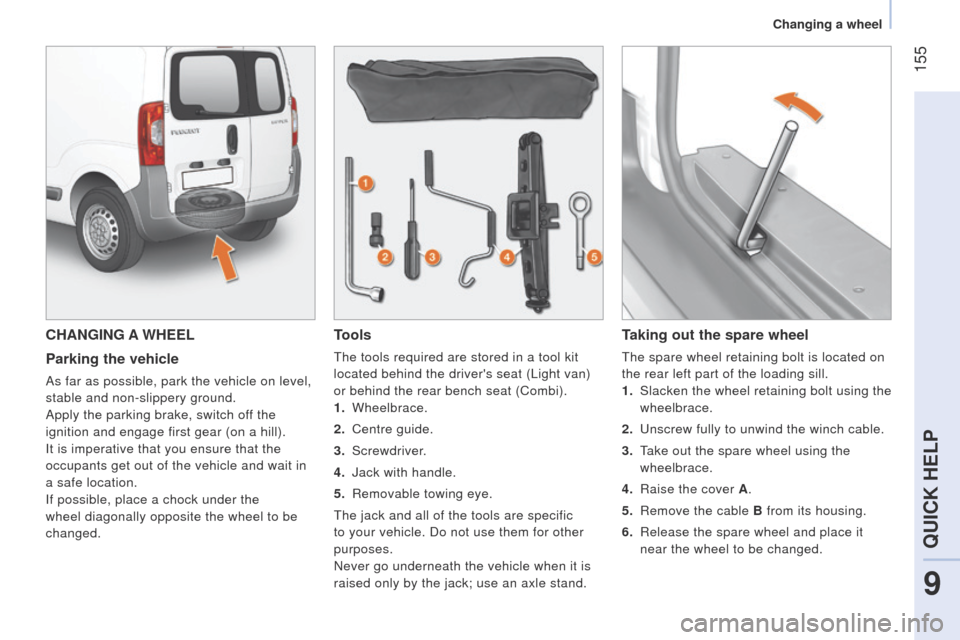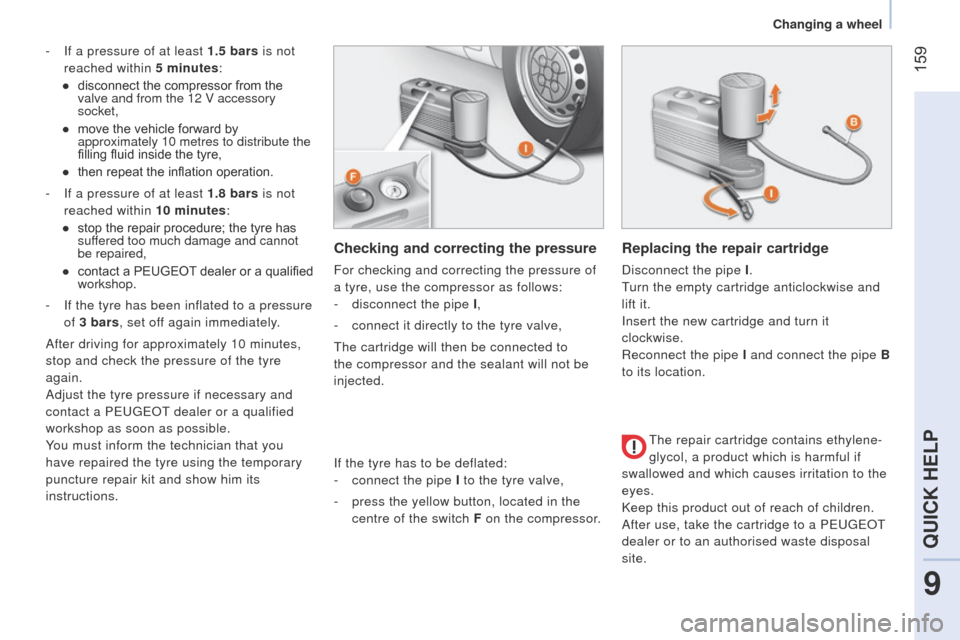Page 139 of 192
137
Bipper_en_Chap07_accessoire_ed02-2014
TOWING A TRAILER, CARAVAN, ETC...
Driving advice
As the fan is electrically controlled, its
cooling capacity is not dependent on the
engine speed.
On the contrary, use a high gear to lower the
engine speed and reduce your speed.In all cases, pay attention to the coolant
temperature.
A towed vehicle must free wheel: gearbox in
neutral.
Cooling: towing a trailer on a slope
increases the coolant temperature.
7
ACCESSORIES
Towing a trailer
Page 142 of 192

140
Bipper_en_Chap07_accessoire_ed02-2014
Range of accessories for private vehicles
Another range is also available from
Peuge O t
dealers.
"Comfort":
insulated module, coat hanger fixed to a
head restraint, reading lamp, rear parking
sensors...
"Transport solutions":
boot liner, rear door net, set of transverse
and longitudinal roof bars, roof boxes...
"Style":
embellishers, secure wheel embellishers... "Security and safety":
anti-intrusion alarm, window etching,
breathalyzer, first aid kit, high visibility vest,
warning triangle, child seats and booster
cushions, snow chains...
"Protection":
rubber mats, over-carpets, 3D mats, seat
covers compatible with lateral airbags, sets
of front and rear mudflaps...
"Multimedia":
audio systems, hands-free kit, speakers,
portable satellite navigation systems, speed
camera detectors, Wi-Fi on board...
By going to a P
euge O t dealer, you can
also obtain cleaning and maintenance
products (interior and exterior) -
including ecological products from the
"
te CHNA
tu
R e " range - products for
topping up (screenwash...), touch-up pens
and paint aerosols for the exact colour of
your vehicle, recharges (cartridge for the
temporary puncture repair kit...), ...
to avoid any risk of jamming of the pedals:
-
ensure that the mat is positioned and
secured correctly,
-
never fit one mat on top of another
.
Equipment
Page 157 of 192

155
Bipper_en_Chap09_aide-rapide_ed02-2014
CHANGING A WHEEL
Parking the vehicle
As far as possible, park the vehicle on level,
stable and non-slippery ground.
Apply the parking brake, switch off the
ignition and engage first gear (on a hill).
It is imperative that you ensure that the
occupants get out of the vehicle and wait in
a safe location.
If possible, place a chock under the
wheel diagonally opposite the wheel to be
changed.
Tools
the tools required are stored in a tool kit
located behind the driver's seat ( l ight van)
or behind the rear bench seat (Combi).
1.
Wheelbrace.
2.
Centre guide.
3.
Screwdriver.
4.
Jack with handle.
5.
Removable towing eye.
t
he jack and all of the tools are specific
to your vehicle. Do not use them for other
purposes.
Never go underneath the vehicle when it is
raised only by the jack; use an axle stand.
Taking out the spare wheel
the spare wheel retaining bolt is located on
the rear left part of the loading sill.
1.
Slacken the wheel retaining bolt using the
wheelbrace.
2.
u nscrew fully to unwind the winch cable.
3.
t
ake out the spare wheel using the
wheelbrace.
4.
Raise the cover
A.
5.
Remove the cable
B from its housing.
6.
Release the spare wheel and place it
near the wheel to be changed.
9
QUICK HELP
Changing a wheel
Page 158 of 192

156
Bipper_en_Chap09_aide-rapide_ed02-2014
Removing a wheel
1. Park the vehicle on level, stable and non-
slippery ground. Apply the parking brake.
Switch off the ignition and engage first
gear or reverse, depending on the slope.
2.
Detach
the wheel trim (large model) using
the wheelbrace 1 , pulling at the valve
passage hole.
Slide the screwdriver
3 into the notch on
the trim (small model) and use the tool as
a lever, pressing to unclip the trim.
3.
Slacken the wheel bolts using the
wheelbrace. 4.
Position the jack underneath the body ,
in accordance with the illustration, at the
mark A (on the sill) as close as possible
to the wheel to be changed.
5.
e xtend the jack 4 until its base is in
contact with the ground.
e nsure that the
centreline of the jack base is vertical in
relation to the location used.
6.
Raise the vehicle.
7.
Remove the bolts and detach the wheel.
Putting the wheel back in place
1. Install the support on the wheel.
2.
Place the cable
B in position.
3.
l ower the cover A .
4.
Position the wheel.
5.
t
urn the wheelbrace clockwise to fully
raise the spare wheel.
Changing a wheel
Page 159 of 192
157
Bipper_en_Chap09_aide-rapide_ed02-2014
Fitting a wheel
6. Put the trim back in place, starting by
placing its notch facing the valve, and
press with the palm of your hand.
7.
Stow the tools and the wheel.
8.
Check the tyre pressure and have the
balance checked. Refer to the "
t
echnical data -
Identification markings" section for
the location of the tyres sticker bearing the
recommended tyre pressures.
1.
Put the wheel in place using the centre
guide 2 to assist you.
2.
Screw in the 3 bolts by hand and remove
the centre guide. Position the 4th bolt.
3.
Pre-tighten using the wheelbrace
1 .
4.
Fold the jack
4 and detach it.
5.
t
ighten the wheel bolts using the
wheelbrace. Have the tightening of the bolts and the
pressure of the spare wheel checked
by a P euge O t
dealer or a qualified
workshop without delay.
Also, have the original wheel repaired and
refitted by a P euge O t
dealer or a qualified
workshop as soon as possible.
9
QUICK HELP
Changing a wheel
Page 160 of 192

158
Bipper_en_Chap09_aide-rapide_ed02-2014
TEMPORARY PUNCTURE REPAIR KIT
this kit is located at the front of the
passenger compartment. It consists of:
-
a repair cartridge
A, containing the
sealant, equipped with:
●
a filling
pipe B,
●
a
sticker C
indicating "max. 80 km/h", which
the driver must affix to the dashboard in a
visible position after repairing the tyre,
-
a compressor
D equipped with a pressure
gauge and unions,
-
adaptors for the inflation of various items,
-
a pair of protective gloves,
-
a quick guide to use of the temporary
puncture repair kit.
Repair procedure
- Apply the parking brake and place the
gear lever in neutral.
-
u nscrew the valve cap of the tyre to be
repaired.
-
t
ake out the filling pipe
B and screw the
ring E onto the tyre valve.
-
Check that the on/of
f switch F on the
compressor is in position "0" (off). -
Start the engine.
-
Insert the connector
G
in the nearest
12 V accessory socket in the vehicle.
-
Place the compressor
’s on/off switch F
in
position "1" (on).
-
Inflate the tyre to a pressure of 3 bars.
to obtain a more accurate reading, you are
advised to check the pressure value on the
pressure gauge H , with the compressor off.
t
his temporary puncture repair kit is
available from P euge O t
dealers.
It is provided for the repair of holes of
a maximum diameter of 4 mm, located
exclusively on the tread or side wall of the
tyre. Avoid removing any foreign bodies
which have penetrated into the tyre.
Changing a wheel
Page 161 of 192

159
Bipper_en_Chap09_aide-rapide_ed02-2014
- If a pressure of at least 1.5 bars is not
reached within 5 minutes:
●
disconnect the compressor from the
valve and from the 12 V accessory
socket,
●
move the vehicl
e forward by
approximately 10 metres to distribute the
filling fluid inside the tyre,
●
then repeat the inflation operation
.
-
If a pressure of at least
1.8 bars is not
reached within 10 minutes:
●
stop the repair p
rocedure; the tyre has
suffered too much damage and cannot
be repaired,
●
contact a PEUGEOT
dealer or a qualified
workshop.
-
If the tyre has been inflated to a pressure
of 3 bars, set off again immediately.
After driving for approximately 10 minutes,
stop and check the pressure of the tyre
again.
Adjust the tyre pressure if necessary and
contact a P
euge O t
dealer or a qualified
workshop as soon as possible.
You must inform the technician that you
have repaired the tyre using the temporary
puncture repair kit and show him its
instructions.
Checking and correcting the pressure
For checking and correcting the pressure of
a tyre, use the compressor as follows:
-
disconnect the pipe
I,
-
connect it directly to the tyre valve,
t
he cartridge will then be connected to
the compressor and the sealant will not be
injected.
Replacing the repair cartridge
Disconnect the pipe I .
turn the empty cartridge anticlockwise and
lift it.
Insert the new cartridge and turn it
clockwise.
Reconnect the pipe I and connect the pipe B
to its location.
t
he repair cartridge contains ethylene-
glycol, a product which is harmful if
swallowed and which causes irritation to the
eyes.
Keep this product out of reach of children.
After use, take the cartridge to a P
euge O t
dealer or to an authorised waste disposal
site.
If the tyre has to be deflated:
-
connect the pipe
I to the tyre valve,
-
press the yellow button, located in the
centre of the switch F on the compressor.
9
QUICK HELP
Changing a wheel
Page 162 of 192

160
Bipper_en_Chap09_aide-rapide_ed02-2014
SNOW CHAINS
In wintry conditions, snow chains improve
traction as well as the behaviour of the
vehicle when braking.
t
he snow chains must be fitted only to
the driving wheels.
t
hey must never be
fitted to "space-saver" type spare wheels.
take account of the legislation in force
in your country on the use of snow
chains and the maximum running speed
authorised. Advice on installation
F
If you have to fit the chains during a
journey, stop the vehicle on a flat surface
on the side of the road.
F
Apply the parking brake and position any
wheel chocks to prevent movement of
your vehicle.
F
Fit the chains following the instructions
provided by the manufacturer.
F
Move of
f gently and drive for a few
moments, without exceeding 30 mph
(50 km/h).
F
Stop your vehicle and check that the
snow chains are correctly tightened.
It is recommended that before you
leave, you practise fitting the snow
chains on a level and dry surface.u se only the chains designed to be fitted to
the type of wheel fitted to your vehicle:
For more information on snow chains,
contact a P
euge O t
dealer or a qualified
workshop. Original
tyre size Maximum
link size.
175/70 R14 9 mm
185/65 R15
Avoid driving on roads that have been
cleared of snow, to avoid damaging
your vehicle's tyres and the road surface. If
your vehicle is fitted with alloy wheels, check
that no part of the chain or its fixings is in
contact with the wheel rim.
Snow chains